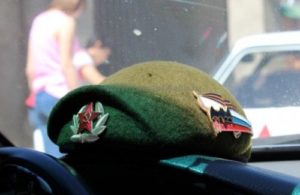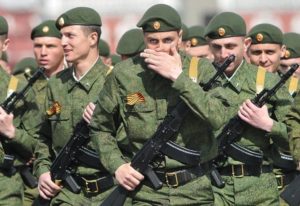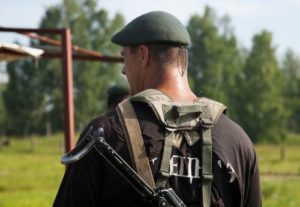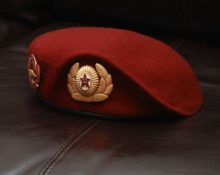Many people know how to distinguish a soldier by his uniform. If there is a person wearing a blue beret, he is an airborne paratrooper; if he is wearing a black one, he is a marine, riot policeman, or a representative of tank forces; if he is wearing an orange one, he is an employee of the Ministry of Emergency Situations. But headdresses of some colors are not so common, and therefore are known to small circles. These include olive berets. Who wears them?
A little history
 In the period after the end of the Middle Ages in Scotland, the beret first began to be used as a mandatory element of the soldier's uniform. Later, in the 19th century, the Spaniards adopted the experience of the Scots when the military needed a functional headdress.
In the period after the end of the Middle Ages in Scotland, the beret first began to be used as a mandatory element of the soldier's uniform. Later, in the 19th century, the Spaniards adopted the experience of the Scots when the military needed a functional headdress.
Indeed, the beret not only protected from bad weather, but was also very convenient in practice: it could be worn under headphones, under a helmet, or easily rolled up and put in a pocket.
Later, the trend spread throughout Britain and America, and only by the 30s of the 20th century it reached the USSR.Since 1936, the beret was introduced as a summer headdress for command staff of female military personnel. Later, starting in 1963, it was introduced for all military personnel of some special forces units.
Now it is a round cap without a visor or ears, made of soft fabric.
Which troops does the olive beret belong to in Russia?
 Currently, this beret is part of the uniform of the Russian National Guard. Previously, it could be worn by military personnel of the Ministry of Internal Affairs of the Russian Federation, as well as special forces of the Twelfth Main Directorate of the Ministry of Defense of the Russian Federation. The latter are responsible for nuclear support in the state and security in this area.
Currently, this beret is part of the uniform of the Russian National Guard. Previously, it could be worn by military personnel of the Ministry of Internal Affairs of the Russian Federation, as well as special forces of the Twelfth Main Directorate of the Ministry of Defense of the Russian Federation. The latter are responsible for nuclear support in the state and security in this area.
Headdresses cannot be worn just like that. The right to wear is certified by passing standards and an award.
Types of Green Berets. What do they mean?
Many members of the Armed Forces of the Russian Federation have the right to wear green berets. It is important to learn to distinguish them, since shades of green vary depending on the type of military:
 green - worn by intelligence officers after passing certain tests and receiving an award;
green - worn by intelligence officers after passing certain tests and receiving an award;- Light green is an attribute of the frontier guards' dress uniform. It is worn during festive ceremonies and other special events;
- dark olive - a uniform element of special forces units of the railway troops;
- directly olive.
When do military personnel receive the Green Beret?
As previously noted, a serviceman can receive a colored headdress only for merit in his service activities or for completing physical standards and tests.
Regulated Standards and Exams
To obtain the right to wear a green beret, soldiers must demonstrate physical and athletic training and general military skills..
Also mandatory conditions are:
 passing an obstacle course through areas with dangerous or difficult terrain;
passing an obstacle course through areas with dangerous or difficult terrain;- ability to fire at a target;
- rescue of the victim;
- holding competitions in hand-to-hand combat;
- storming a building or recognizing an ambush.
How to get an olive beret?
The Olive Beret can be obtained in two ways: by passing an exam or receiving a merit award. How the opportunity to wear this badge of honor was obtained does not matter. Both options are equally honorable and prove the courage and responsibility of the serviceman.
The exam takes place only once a year and consists of a series of very difficult tests that the strongest and most resilient can complete.. Every serviceman of certain troops of the Armed Forces of the Russian Federation can take part in the exam: both those who serve under a contract and conscripts for compulsory military service.
The first stage, preliminary, consists of several types of tests that must be passed one after another:
 cross-country with a length of 3 kilometers;
cross-country with a length of 3 kilometers;- pull-ups;
- push ups.
After successfully completing the preliminary stage, the military proceeds to the second stage. Contenders for the title of best perform a number of tasks, including:
- forced march. It consists of overcoming rough terrain with hills and lowlands, as well as water boundaries that must be crossed. The task is performed in full equipment weighing about 12–15 kg. The duration of the passage is no more than 2 hours. The right to rest is not given;
- passing a course with obstacles;
- storming a building or structure;
- shooting, where skills of accuracy and efficiency are demonstrated;
- hand-to-hand combat - sparring with several partners for 12 minutes.
Passing all the standards is a difficult task, feasible only for the most resilient. Mental stress during testing is also common, which is why only the most worthy are given the right to wear the olive beret.
The second basis for obtaining the right to wear this headdress is the award of an award for merit in the performance of official duties. This method is no less worthy and does not reduce honor in any way.
Interesting Facts
 according to statistics, only half of the military reaches the end of the test on the test strip;
according to statistics, only half of the military reaches the end of the test on the test strip;- the procedure for obtaining the right to wear an olive beret almost completely coincides with the tests for obtaining a maroon beret of the Russian Guard;
- The crimson Airborne beret was replaced with a blue one in the late 70s. It continues to this day. According to rumors, the replacement was made in order to deceive the Czechoslovak army. It is a myth. In fact, this was done according to plan and so that the color of the headdress would match the color of the buttonholes on the uniforms of the airborne troops.


 green - worn by intelligence officers after passing certain tests and receiving an award;
green - worn by intelligence officers after passing certain tests and receiving an award; passing an obstacle course through areas with dangerous or difficult terrain;
passing an obstacle course through areas with dangerous or difficult terrain; cross-country with a length of 3 kilometers;
cross-country with a length of 3 kilometers; according to statistics, only half of the military reaches the end of the test on the test strip;
according to statistics, only half of the military reaches the end of the test on the test strip; 0
0





